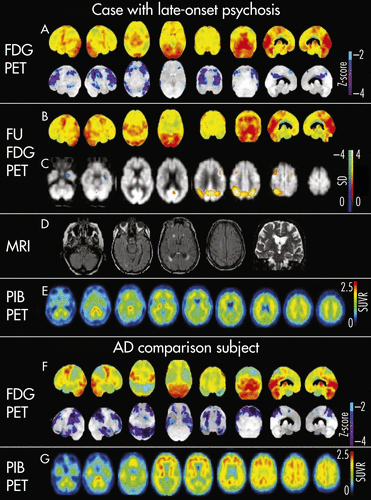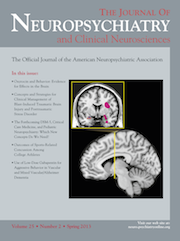Reversible Parietal Hypometabolism in Late-Onset Psychosis
To the Editor: Late-onset psychosis constitutes a major diagnostic challenge, especially the differentiation between a late presentation of a psychotic disorder versus a behavioral presentation of Alzheimer’s disease (AD). Among others, reduced parietal and posterior temporal glucose metabolism is used as a supportive feature for the diagnosis of AD.1 We report a case with late-onset psychosis, cognitive impairment including memory, and reduced glucose metabolism on 18F-FDG PET including parietal cortex, suggestive of AD. However, during follow-up, cognitive status improved; parietal metabolism increased; and an 11C-PIB-PET scan was negative, warranting cautious interpretation of metabolic changes in late-onset psychosis.
Case Report
A 74-year-old woman with a history of depression, craniocerebral trauma during adulthood, and a TIA, was admitted to the neurosurgery department because of pain in the right lower limb due to lumbosacral plexopathy. While undergoing examinations, she became convinced that her hospital stay was part of a conspiracy, that she was being used for medical experiments, and was to be poisoned by medication. She accused one physician of maltreating her, sent secret messages by phone, accused caregivers of theft, and believed that walls were permeable through invisible holes. A disturbance of consciousness was never observed. Subjective memory complaints were present before admission, and cognitive difficulties were observed during hospitalization, confirmed by MMSE (15/30). An antipsychotic drug was started, and she was referred to the geriatric psychiatry ward. Mental examination at admission revealed a conscious, cooperative, but suspicious woman with paranoid delusions without hallucinations, incoherent formal thinking, and disorganized speech. Neuropsychological testing revealed poor sustained attention, executive dysfunction, and episodic memory impairment. MRI showed periventricular leukomalacia, but no recent ischemia. 18F-FDG PET revealed severe hypometabolism of bilateral parietal, posterior temporal and frontal cortex (Figure 1), a pattern suggestive of AD. Psychotic symptoms improved gradually, as well as cognitive status, with an MMSE score of 25 after 15 weeks of hospitalization. A follow-up 18F-FDG PET, 3 months after the initial one, showed a relative increase of parietal metabolism. During 4 years of follow-up, cognitive status remained stable despite memory complaints. An 11C-PIB PET did not show abnormal cortical amyloid deposition (Figure 1). However delusional ideas persisted, allowing a diagnosis of very-late-onset schizophrenia-like psychosis.2

[A–E]: Neuroimaging results from a 74-year-old woman with late-onset psychosis. [A]: Upper row 18F-FDG PET scan. Lower row: stereotactic surface projections with areas of significant hypometabolism superimposed (z-scores with respect to normal dataset of 30 control subjects); [B]: Follow-up 18F-FDG PET scan after 3 months; [C]: Subtraction of [A] from [B]. Yellow indicates significant increase, and blue significant decrease of metabolism; [D]: MRI scan including axial slices of a FLAIR sequence and a coronal slice at the level of the hippocampus of a T2-weighted sequence; [E]: Negative 11C-PIB PET scan (standard uptake value ratio [SUVR] values are used as a measure of amyloid binding); [F–G]: neuroimaging results from 71-year-old woman with Alzheimer’s disease; [F]: 18F-FDG PET data; and [G]: a positive 11C-PIB PET scan.
Discussion
Late-onset delusions may be an early symptom of AD. On the other hand, psychotic disorders in elderly persons are often associated with cognitive impairment. Because of the clinical overlap, neuroimaging is considered an important diagnostic tool, with temporoparietal hypometabolism and a positive 11C-PIB PET being supportive of AD diagnosis.1 In contrast, neuroimaging findings in late-onset psychotic disorders that have been described so far, are generally nonspecific, including enlarged ventricles, white-matter changes,3 and hypoperfusion of frontal and temporal cortex measured by SPECT.4,5 Until now, no 18F-FDG PET studies have been reported in late-onset psychosis. Our case report illustrates that, in addition to frontal metabolic changes, late-onset psychosis can be associated with severe parietal hypometabolism. In contrast with the natural evolution of AD, we observed a partial recuperation of parietal hypometabolism over time associated with improvement of cognitive status and reduction of psychotic symptoms.
1 : Research criteria for the diagnosis of Alzheimer’s disease: revising the NINCDS-ADRDA criteria. Lancet Neurol 2007; 6:734–746Crossref, Medline, Google Scholar
2 :
3 : Late-onset schizophrenia and very-late-onset schizophrenia-like psychosis, in the Oxford Textbook of Old Age Psychiatry. Edited by Jacoby ROppenheimer CDening T. New York, Oxford University Press Inc., 2008, pp 617–626Google Scholar
4 : Regional cerebral blood flow in late-life onset psychosis. Neuropsychiatry Neuropsychol Behav Neurol 1992; 158:132–137Google Scholar
5 : Regional cerebral blood flow in late-onset schizophrenia: a SPECT study using 99mTc-HMPAO. Schizophr Res 1997; 27:105–117Crossref, Medline, Google Scholar



